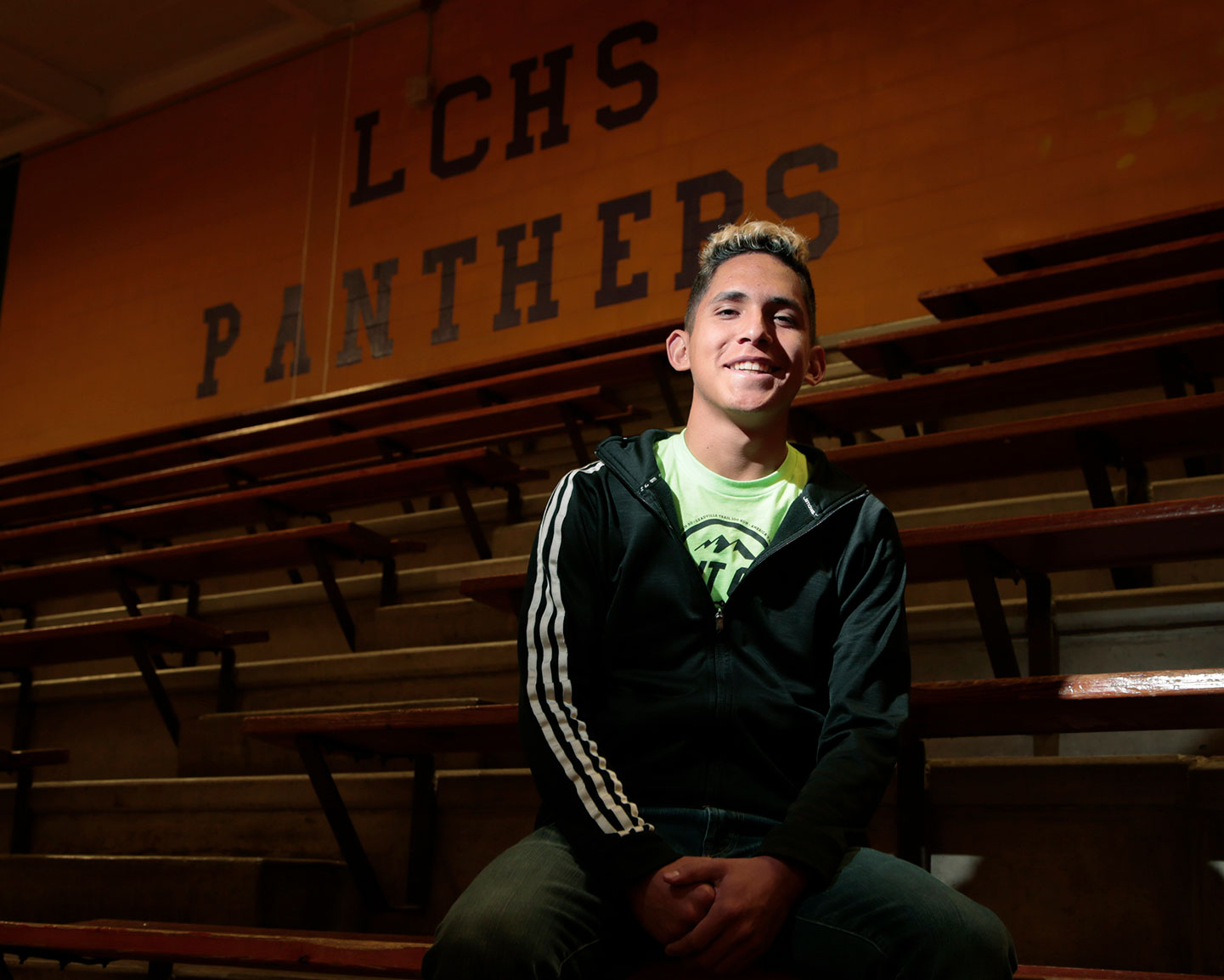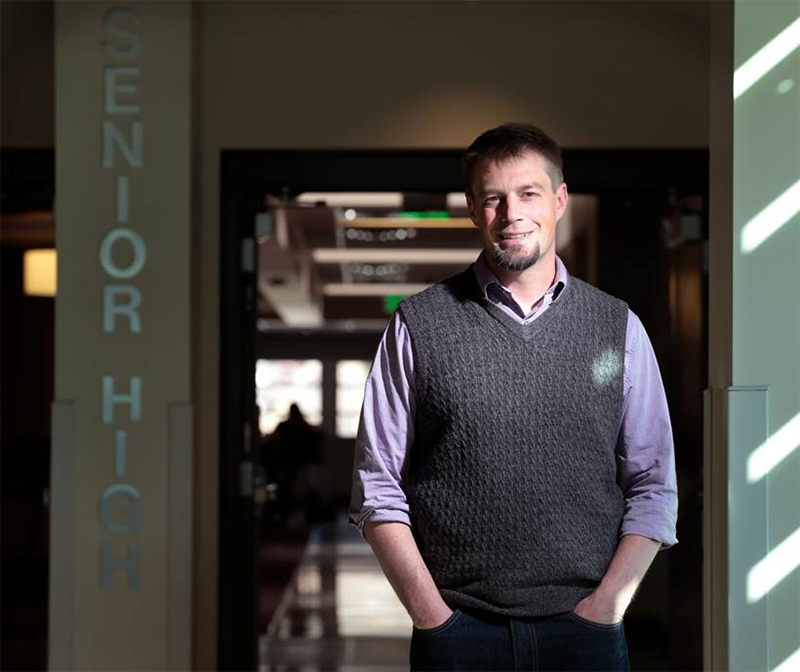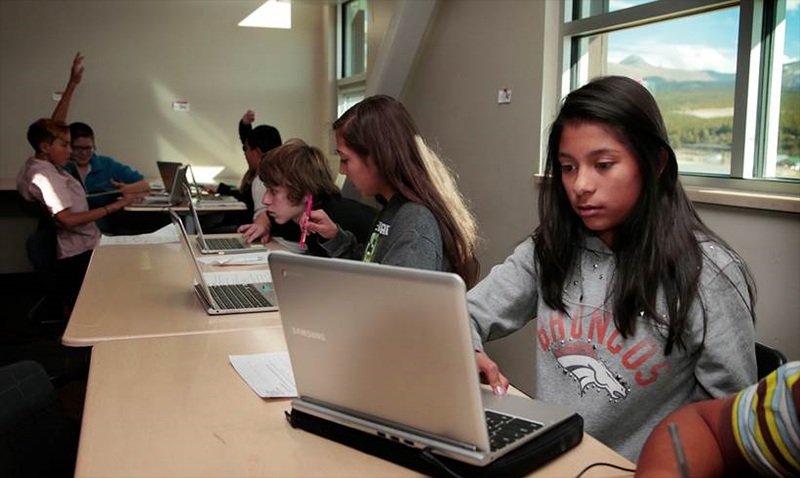
Angel Martinez, a senior at Lake County High School in Leadville, Colo. Photo by Joe Mahoney
Angel Martinez, a senior at Lake County High School in Leadville, Colo. Photo by Joe Mahoney
As soon as he threw the punch, Angel Martinez knew he had made a mistake with potentially life-altering consequences.
A multi-sport athlete at Lake County High School in Leadville, Colo., Martinez let his temper get the best of him in the waning moments of a tough soccer match in September against Jefferson High School, and connected with a hard right cross to an opponent’s jaw.
Martinez, who wants to attend college next year to study chiropractic medicine, sports psychology or athletic training, saw all those hopes flash before his eyes as he backpedaled away from the ensuing scrum.
“I thought I’d get kicked off the team and suspended for sure,” said Martinez, reflecting on the incident six weeks later. “It was a physical game and everyone was getting mad, but I’m the one who swung first.”
It didn’t help that the moment and the ensuing brawl were caught on video, which ended up on a Denver-area TV newscast the night of Sept. 7. Martinez, a wiry senior with wavy dark hair punctuated by a bleached streak, is easily recognizable in the video.
Martinez returned to school the next morning dreading the anticipated punishment. In past years, he could have expected to be kept out of school for several days, and removed from the team. He also could have expected possible repercussions down the line, once school records for college applications came due.
This time, however, there was no suspension, no recriminating words.
Instead, he and his teammates were called into a meeting to discuss what had happened, and to accept responsibility for the debacle. The session was mediated by their coach, along with Lake County High School Principal Ben Cairns and other teachers as part of the school’s new restorative justice approach to discipline issues.
During that meeting, the team decided that it wasn’t enough for Martinez and others involved to issue apologies to their teammates and their school. The entire team decided to reach out to Jefferson High School and make amends there as well.
A few days later, the Lake County High School soccer team piled onto a school bus for the mountainous, 90-minute drive down to Lakewood, a Denver suburb. Although Martinez and his teammates were anxious about the meeting, their concerns proved to be unfounded.
“We recognized pretty fast once we started talking that we had a lot in common. We are similar schools, with large Latino populations,” Martinez said.
During the meeting, Martinez apologized for instigating the brawl and accepted responsibility for his actions. His teammates and Jefferson players stepped forward as well and apologized for their roles.
It was really good, how it turned out, Martinez said. “Everyone opened up, admitted mistakes.” The two sides parted feeling reconciled—even friendly—toward one another.
“I’m friends with one of their guys on Facebook now,” Martinez said.
The way Lake County School District educators and students dealt with the brawl exemplifies the district’s evolving approach toward discipline. A school discipline report card released last August by Padres & Jóvenes Unidos, a Denver-based advocacy group and a grantee of The Colorado Trust, found that Lake County’s discipline practices had led to some of the state’s highest out-of-school suspension rates, especially among its large number of Latino students.
The most recent state data available show that during the 2014-15 school year, Lake County schools issued 11.7 out-of-school suspensions for every 100 students. That’s the tenth highest rate among Colorado’s 179 school districts.
And the numbers were slightly worse for suspensions of students of color: 12.7 per 100, also the tenth-highest rate in Colorado.
Wendy Wyman is in her fifth year as Lake County’s school superintendent. During her tenure she has led a large-scale turnaround process for the district’s schools, which were failing under the state accountability system and in need of a major overhaul.
Schools that remain in the two lowest rating categories—priority improvement and turnaround—for five consecutive years are subject to possible state intervention under the terms of a 2009 law that revamped the state accountability system for rating districts and schools. Lake County has shown steady improvement, but was in its fifth year “on the clock” in 2014-15 when a change in state tests paused the clock for a year. District officials are optimistic they will get off the clock when it resumes ticking next year.
“My hope is that we can continue to get better and better at identifying where kids need behavioral supports,” Wyman said. Changing discipline practices “is an important part of our reform journey.”
Leadville is a blue-collar mountain community, known for its high altitude (10,152 feet above sea level) and stunning views of the state’s highest peaks. For much of its history the town relied on mining for its employment base, but it’s now more geared toward tourism and service industries.
Housing in Leadville is affordable compared to prices in neighboring resort communities. As a result, over the past 20 years, hundreds of people who work for the nearby ski resorts in Summit County and the Vail Valley have moved to Leadville, despite the often hair-raising commute over mountain passes. Many of those workers are Latino immigrants who speak little or no English.
Today, the student body of Lake County High School (grades 7-12) is 72 percent Latino, and 75 percent of the school’s students come from families with incomes low enough to qualify for federally subsidized lunches. Yet the teaching staff is 96 percent white.
Even before the Padres discipline report, district officials recognized they had a problem with their discipline policy that needed addressing. The origins of the problems didn’t lie with the students, district leaders said, but rather with inconsistent, at times draconian discipline policies that were unevenly, even capriciously enforced.
This, coupled with unexamined biases among district personnel, led to high suspension rates, which provided a short-term fix to discipline problems but had much more serious long-term effects on students.
“Suspensions lead to bad outcomes and risky behaviors,” said Cairns, a first-year principal who came to Leadville after running a charter high school in northeast Denver.
“If you’re not in school, it’s safe to say you’re probably not doing good things.”

Ben Cairns, principal at Lake County High School. Photo by Joe Mahoney
Cairns’ concerns are supported by a 2003 American Academy of Pediatrics policy statement, which concluded that out-of-school suspensions “exacerbate academic deterioration, and when students are provided with no immediate educational alternative, student alienation, delinquency, crime, and substance abuse may ensue.”
Among its nine recommendations, the policy statement urged schools to limit out-of-school suspensions to “the most egregious circumstances”:
For in-home suspension or expulsion, the school must be able to demonstrate how attendance at a school site, even in an alternative setting with a low ratio of highly trained staff to students, would be inadequate to prevent a student from causing harm to himself or herself or to others.
According to a report from the Justice Policy Institute, harsh, “zero-tolerance” policies enacted by school districts beginning in the 1990s increased suspension rates dramatically, especially for students of color, and African American males in particular.
“Especially for older students, trouble at school can lead to their first contact with the criminal justice system. And in many cases, schools themselves are the ones pushing students into the juvenile justice system—often by having students arrested at school,” the study said.
When Cairns was offered the Lake County High School job last spring, he immediately set out to shift the school culture to one where behavior expectations are explicit, clear consequences exist for violation of those expectations, and where punishment is proportional to the infraction.
In previous years, students could get several days of after-school detention for being late to one class. But such policies were spottily enforced, and students found ways around them. “If they were going to be late, often they’d just leave for the day,” Cairns said.
So when he came in, Cairns decided to make rules that were clear and simple. The combination of stricter rules, clear consequences and the softer approach of restorative justice help shift a school’s culture, he said.
Now, students know the rules, and know they’ll be enforced. If you’re late to class, you get one lunch detention. If you swear, that’s a lunch detention. If you sneak a cell phone into a class, lunch detention.
“Those are the three little rules that everybody knows,” senior Martinez said. “We all got the hang of it pretty fast. On the first day of school, my friend was on his phone, and Mr. Cairns took it away and told him he could have it back at the end of the day.
“Things like that, at first there were a bunch of gasps, a lot of ‘whoa, that’s BS.’ But now we understand that this is a professional environment. We’re here to learn. It’s not a mall, it’s a school.”
Teachers find the combination of clear guidelines, strict enforcement and compassionate intervention to be a welcome change.
“Being able to enforce infractions without overreacting is great,” said Scott Carroll, the high school’s director of choral music and theater. “And kids understand that lunch detention is more of a learning opportunity than a punishment.”
Student behavior has improved as a result, Carroll said. “At the beginning of the year we had 35 to 40 kids in lunch detention most days. Now it’s down to eight to 10,” he said.
But for what Cairns calls “more nuanced stuff”—say, if a student says a teacher is being unfair, or if a teacher feels a student is disrespectful—the two engage in a restorative justice process. If two or more students are in ongoing conflict, they also enter restorative justice.
Though the concept seemed alien to students at first, they’re coming around to it as the semester progresses. Arianna Hermosillo, a seventh-grader, and her friend Brittany started spreading rumors about another girl, Lucy (not their real names, for privacy reasons), with whom they’d had a falling out. Lucy was upset and hurt, and her big sister had threatened to beat up the gossiping pair if they kept tormenting her sister.
 “Our teacher put the three of us together and had us talk about how being called names can affect us, how rumors can affect us,” Hermosillo said. “It was just the three of us in the conversation. Lucy explained how she felt about it—that she had almost decided to stop coming to school.”
“Our teacher put the three of us together and had us talk about how being called names can affect us, how rumors can affect us,” Hermosillo said. “It was just the three of us in the conversation. Lucy explained how she felt about it—that she had almost decided to stop coming to school.”
Hermosillo and Brittany owned up to what they said and agreed that they needed to “fix things.” The first step, they agreed, was to start eating lunch together again.
Hermosillo said she felt good after her talk with Lucy. “I mean, we’re in seventh grade. We need to learn how to handle our own conflicts,” she said.
While this may sound like the kind of middle school drama that’s acted out countless times each day in hallways and on playgrounds across the country, consider what could have resulted had the intervention not occurred. Lucy could have stopped coming to school, putting her grades and even her health at risk. Lucy’s big sister could have physically confronted Lucy’s tormentors, leading to an out-of-school suspension.
Instead, the conflict was resolved, and no one missed any time or faced any harsh punishment.
Wyman, the Lake County superintendent, said she wants to assure that all teachers and school staff are trained so that they “have the needed skills to help kids work through conflicts.”
Cairns is quick to point out that out-of-school suspensions have their place. “If it’s a school safety issue and we need a day or two to make a plan, we’ll do it,” he said. His preference when it comes to suspensions is to make them short—less than a full day.
“If two boys fight, better to send them home for the rest of the day to cool off and think about it,” he said. That way, they miss only a couple of classes. When they return, they go through a restorative justice process.
Wyman said the district as a whole needs to come to a better understanding of the purpose of out-of-school suspensions. “Is it a time-out or is it something that has to happen because the harm has been great enough?” she said.
The shift in discipline practices only started this fall, so it’s too early to look for a change in suspension data collected by the state. Cairns said what’s lacking in state suspension data is the length of suspensions, which he argued matters more than the simple fact of suspension. A kid who is sent home for half a day may benefit from the downtime, while a multi-day (or longer) out-of-school suspension can have deleterious impacts.
The next step Lake County is taking to reduce suspensions is to “help our staff understand their own culture and background,” Wyman said. “We all need to think about our biases, how and when they show up. And people need to feel safe talking about it.”
Related stories: